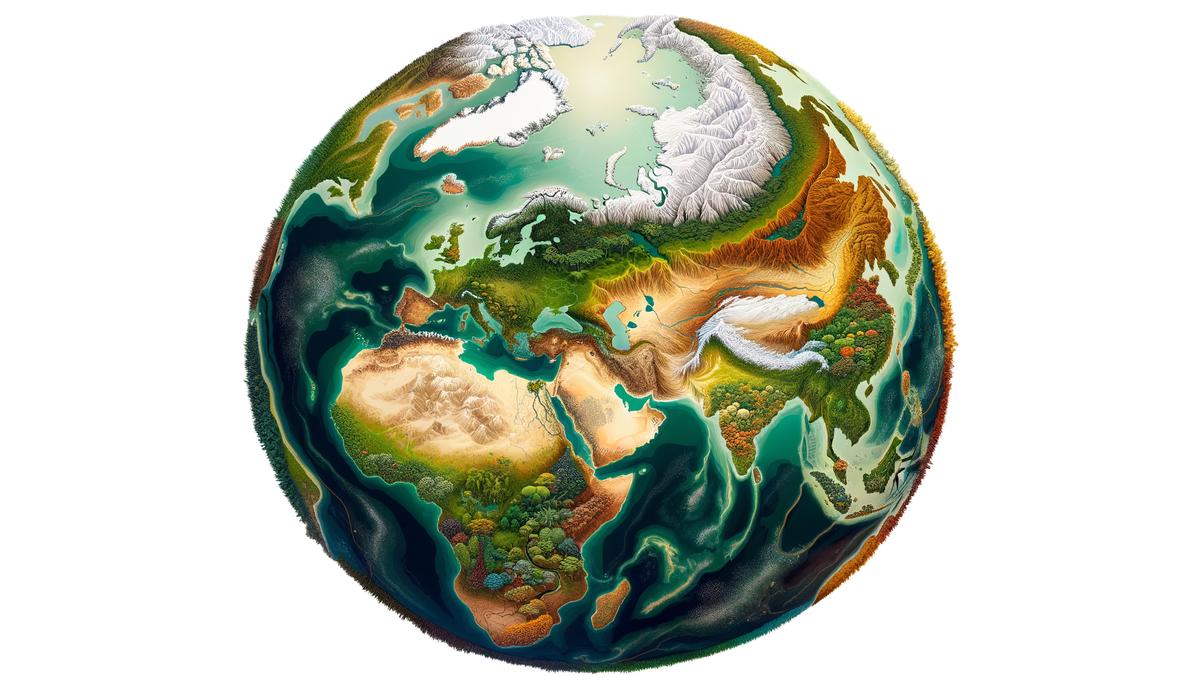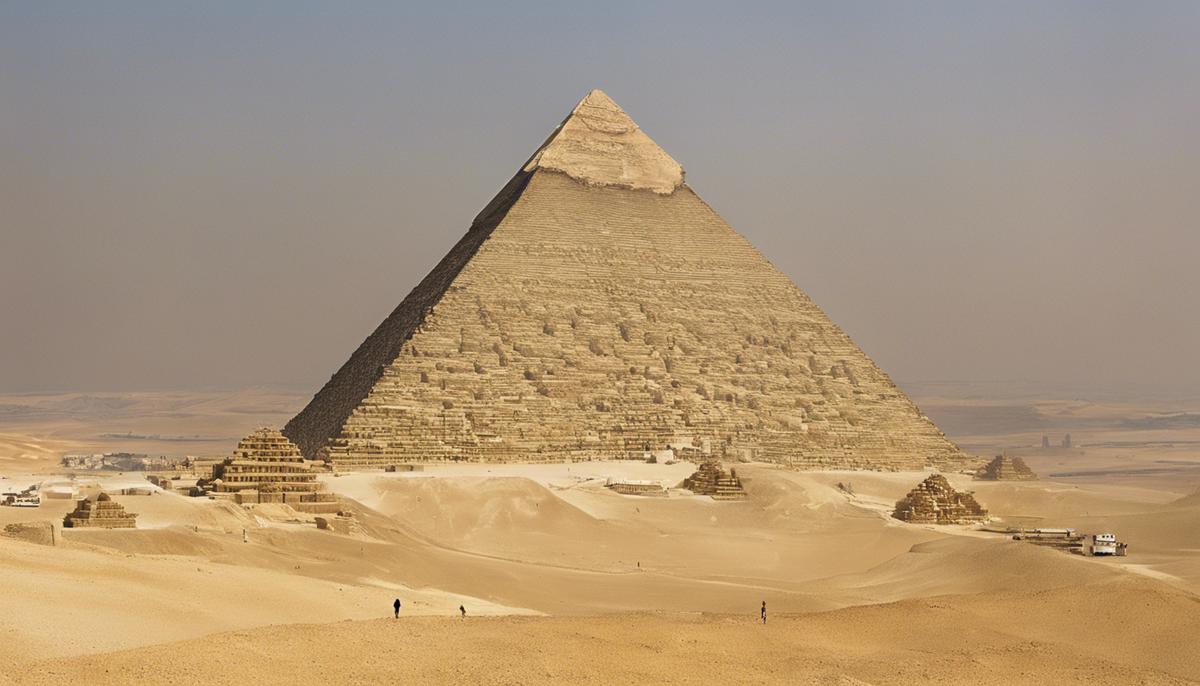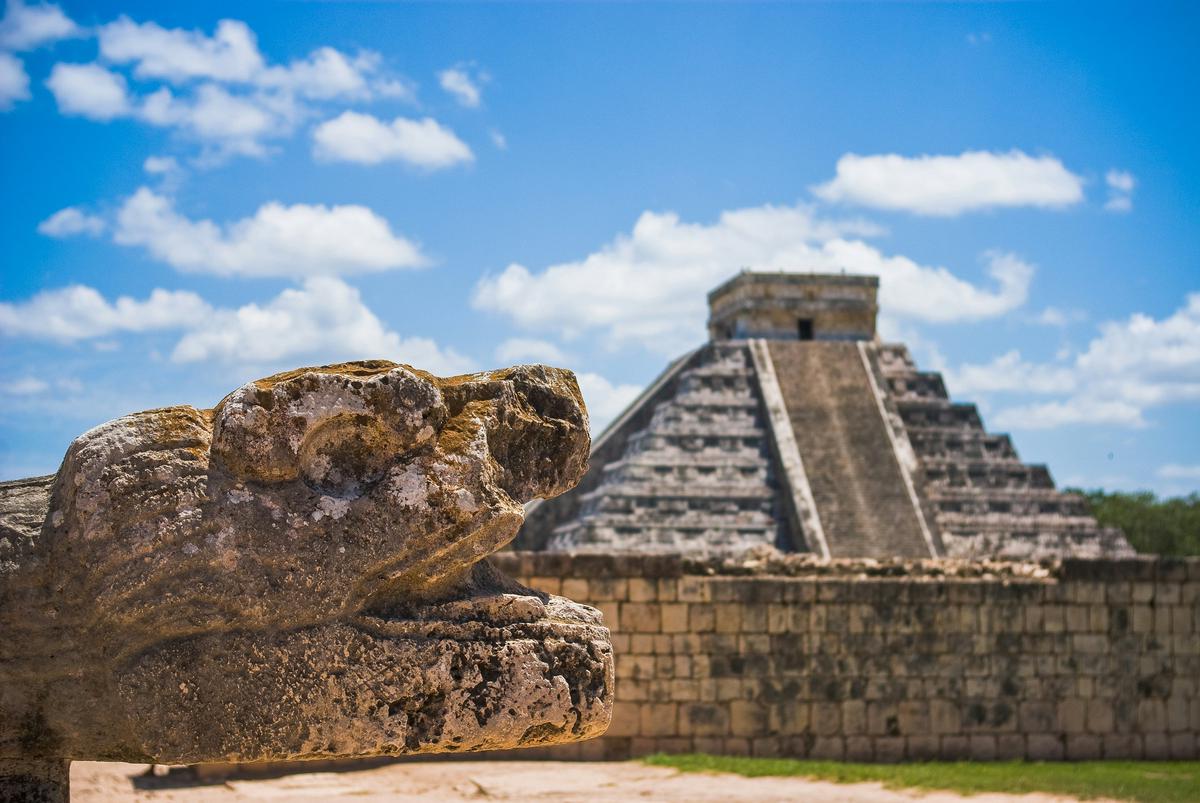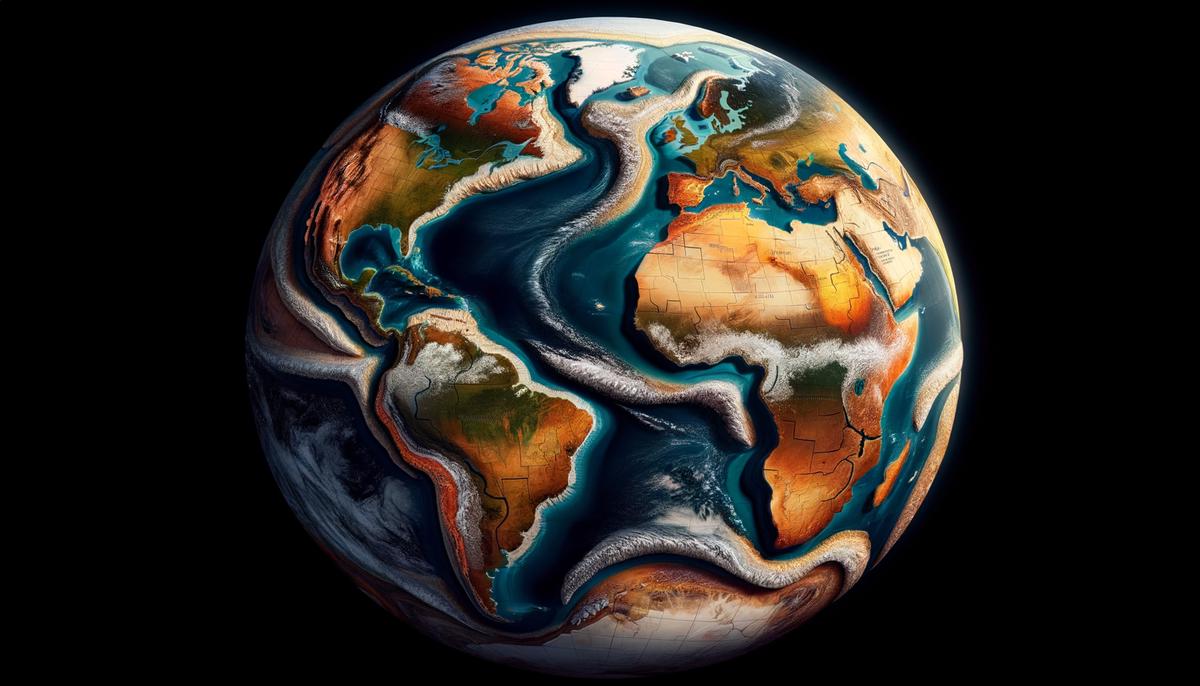Pangaea’s Influence
Pangaea, a supercontinent that existed about 320 million to 195 million years ago, played a pivotal role in shaping the world's climate, geography, and the history of life on Earth. Its formation pulled together land masses, creating a single, immense landform surrounded by a vast ocean known as Panthalassa. This massive geographic shift had profound effects on climate, flora, fauna, and human migration patterns.
The presence of one giant landmass meant significant climatic differences from the current configuration of continents. The interior regions of Pangaea might have experienced extreme dryness due to the lack of moisture from the surrounding ocean, similar to desert environments today. In contrast, areas nearer to the coast or at equatorial regions would have experienced a lush, tropical climate, evidenced by coal deposits found in what is now the United States and Europe, indicating ancient rainforests.
These variations in climate had direct impacts on the distribution of plant and animal life across Pangaea. The uniform climatic conditions allowed for certain flora and fauna to spread wide across the continent. This widespread distribution of similar types of plants and animals across large distances laid down a framework that would affect the evolution of species long after Pangaea's breakup.
The breakup of Pangaea, occurring from around 195 million to 170 million years ago, was another event with long-lasting implications for our planet's geological and biological history. As the continent split and drifted apart due to tectonic forces, it led to isolated land masses. This isolation resulted in diverse evolutionary paths for life on different continents, contributing to the biodiversity we see today.
Human migration and the development of ancient civilizations were also influenced by Pangaea's legacy. The supercontinent's division created separate landmasses with unique climates, resources, and geographical barriers. These new continents offered different challenges and opportunities for human societies. The rise of civilizations along river valleys such as the Nile, Tigris-Euphrates, and Indus can be traced back to the way Pangaea's breakup oriented those continents and positioned those rivers as lifelines in otherwise challenging environments.
Pangaea's vast size and uniformity meant that it served as an incubator for early life, allowing species to spread and adapt over great distances without the obstacle of oceans. As Pangaea broke apart, species were subjected to new environments and selective pressures, leading to a burst of evolution known as adaptive radiation. The isolation of populations by the formation of oceans and seas led to speciation, where new species evolve from a common ancestor to fill different ecological niches.
Trade routes and cultural exchanges among ancient civilizations were inevitably shaped by Pangaea's breakup as well. Age-old trade networks across Eurasia, connecting East and West, were determined by geographical features resulting from tectonic movements that began with Pangaea. Mountains, deserts, and oceans formed natural barriers that early traders had to navigate, influencing the flow of goods, ideas, and cultural practices across regions.
Pangaea's formation and eventual fragmentation into the continents we know today have played a fundamental role in shaping Earth's climate, biology, and even human society. Changes in climate influenced where ancient peoples settled, what kind of societies they built, and how those societies interacted with one another. The distribution of plants and animals across the planet facilitated by Pangaea's existence and later segregation after its breakup has left an indelible mark on the earth's biosphere and contributed to the diversity of life via evolutionary pressures unique to each resulting continent. Understanding Pangaea's influence offers insights into earth's past that illuminate the interconnectedness of climate, geography, and the development of human civilizations across the globe.

Architectural Marvels
The architectural feats accomplished by ancient civilizations remain among the most enduring legacies of their time, illustrating superior engineering ingenuity and profound organizational and resource management capabilities. Structures such as the Great Pyramid of Giza, the Forbidden City in Beijing, and the Colosseum in Rome stand as testaments to the architectural innovation and societal organization prevalent in ancient times.
The construction of the Great Pyramid, dating back to around 2580–2560 BC, showcases the ancient Egyptians' mastery of engineering and their understanding of mathematics and astronomy. The preciseness of its orientation to the cardinal points suggests a knowledge level that modern engineers still admire. Crafting such a monument required not just physical resources but a vast labor force meticulously organized, debunking earlier theories of slave labor in favor of a more nuanced understanding of skilled workers who labored on the pyramid as a form of tax payment and lived in well-provided communities. This reveals a societal organization geared towards monumental projects, with the pyramid symbolizing a unifying national project of religious significance.
The Forbidden City, built in the early 15th century under the Ming Dynasty, showcases an advanced understanding of spatial organization, symbolism, and sustainable construction practices. Its precise layout, following strict philosophical and geomantic principles, aimed to harmonize with natural and supernatural worlds. The intricate wood joints and brackets used in its construction demonstrate an engineering acumen that allowed these wooden structures to withstand the rigors of time and natural disasters. The organization required to mobilize and sustain such a construction effort illustrates the imperial power's extent and the centralized bureaucratic system's efficiency, which was key to managing the empire's vast resources.
The Colosseum in Rome, an iconic symbol of Roman engineering prowess, highlights an understanding of materials and an ability to innovate structurally. Utilizing concrete—a Roman innovation—the Colosseum's builders could create a durable and versatile structure faster and more economically than would have been possible with stone alone. Its design, incorporating tiered seating, wide entrances, and a complex system of corridors and staircases, optimized spectator flow and visibility, reflecting an advanced grasp of crowd control and urban design. The rapid build time and resource efficiency demonstrated the Roman Empire's logistical capabilities and its societal organization, which allowed for considerable public works aimed at entertainment and asserting imperial prestige.
These structures were manifestations of each civilization's societal structure, political organization, and cultural priorities. The ability to conceptualize such intricate designs and execute them with the engineering tools available at the time underscores a deep connection between each society's architectural endeavors and its prevailing technological capacities, economic systems, and collective ambitions. These masterpieces not only push the boundaries of what was architecturally possible but also provide insights into the complex fabric of ancient societies that created them.

Cultural Exchange Mechanisms
Throughout history, the forces of trade, conquest, and exploration have woven a tapestry of interconnected societies, facilitating cultural exchanges that have significantly shaped the trajectory of human development. The movement and mingling of peoples across landscapes led not only to the exchange of goods but also to the sharing of ideas, practices, and beliefs that have enriched civilizations.
Trade routes served as the arterial roads for this exchange. The Silk Road, a network that connected the East and West, symbolized the intense desire for trade and the exchange of luxuries like silk, spices, and precious metals. But alongside these tangible items, intangible assets flowed. Technologies such as papermaking and gunpowder, both invented by the Chinese, found their way into the hands of Europeans, fundamentally altering their societies. The Islamic Golden Age saw significant advancements in mathematics, astronomy, and medicine, knowledge that would later permeate into European thought and help spark the Renaissance.
Conquest also played a crucial role in cultural exchange. The expansion of empires often led to the assimilation and integration of diverse cultures.
- The Roman Empire, through its vast dominion around the Mediterranean, assimilated various cultures into its fold, adopting deities from the Egyptians, architectural styles from the Greeks, and making Latin the lingua franca of the Western world.
- Alexander the Great's empire acted as a giant melting pot, fostering a blend of Greek, Persian, Egyptian, and Indian cultures which gave rise to the Hellenistic Age – a period marked by an extraordinary level of cultural exchange and intellectual ferment.
Exploration, driven by curiosity and the pursuit of wealth, led to the discovery of new lands and the initiation of contact between distant civilizations.
- The Polynesians, navigating by stars, settled in the vast islands of the Pacific, establishing networks of trade and cultural exchange.
- The Age of Discovery expedited global cultural interchange, albeit disruptively, integrating the New World into the international trade systems and initiating unprecedented exchanges. Notable is the Columbian exchange which saw foods, plants, animals, and diseases exchanged between the New and Old Worlds.
The impact of these networks on agriculture was significant. The global spread of crops such as maize from the Americas or rice from Asia fundamentally changed diets and agricultural practices worldwide. These agricultural exchanges impacted social structures, economy, and even the landscape of regions.
Language and religion, intrinsic elements of any culture, spread across continents through these networks. The spread of Latin with the Romans or Arabic with the expanding Islamic caliphates led to significant linguistic changes and the integration of various languages. Major religions like Buddhism spread from India to East Asia through the Silk Road, while Christianity spread across the Roman Empire and beyond through conquest and conversion.
The mechanisms of trade, conquest, and exploration have been central to our shared history. They have not only facilitated the movement of goods but have fundamentally altered societies by interlinking distant peoples through cultural exchanges. These interactions have led to the spread of technologies, agricultural practices, languages, and religious beliefs, fostering the development of diverse yet interconnected societies that reflect the rich tapestry of human civilization. This historical framework shapes our understanding of global inclusivity and interconnectedness in the contemporary world.

Collapse and Continuity
The annals of history are littered with tales of once-mighty civilizations that faced decline or outright collapse. Factors such as environmental changes, warfare, and social upheaval often stand out as primary reasons behind their downfalls. However, it's intriguing to see how remnants of these ancient cultures persist, weaving their essence into the fabric of modern societies.
Environmental changes have played a crucial role in shaping the destiny of ancient civilizations. The Classic Maya collapse, for instance, provides an example where prolonged droughts, possibly exacerbated by deforestation and soil degradation, challenged the societal structures that the Mayan civilization rested upon. Agricultural yields dwindled, sparking political instability and social unrest. Yet, the shadow of Mayan architecture, their complex calendar system, and their hieroglyphic writing continue to mesmerize and influence scholar thought and cultural practices in the regions they once inhabited.
Warfare has often catalyzed the fall of civilizations. The Western Roman Empire's inability to stem the tide of invading barbarian tribes marked the end of centuries of Roman hegemony in Western Europe and also heralded a period of social and economic disarray. However, Roman principles of law and governance, their engineering feats in the form of roads and aqueducts, and Latin, the precursor to the Romance languages, have survived, testifying to the empire's lasting influence on subsequent European development.
Social upheaval, driven by internal conflicts or economic disparity, has also been central to the demise of civilizations. The French Revolution, spurred by social inequality and economic hardship, marked the end of France's absolute monarchy but also planted the seeds of modern democratic ideals. These revolutionary ideals of liberty, equality, and fraternity echoed through the centuries, inspiring social justice movements and governance structures around the globe.
It is remarkable how certain facets of ancient civilizations have interwoven into the modern fabric, despite their apparent collapse.
- The Greeks' philosophical inquiries laid the groundwork for Western intellectual traditions. Their ideas on democracy continue to inspire governance models worldwide.
- Vestiges of Egyptian art and mythology enchant millions, as they find resonance in modern literature, cinema, and aesthetics.
The Silk Road, an ancient trade network, not only facilitated economic transactions but also cultural exchanges that have sculpted distinct civilizations. Its legacy, seen in the spread of Buddhism across Asia and the remnants of trade cities along its path, speaks of a time when connectivity bridged vast and diverse cultures.
Examining these factors and their repercussions reveals a complex tapestry of human development where even in decline, elements of continuity serve as milestones or beacons for future explorations. Ancient civilizations, through their rise and fall, exhibit a certain resilience; their knowledge, traditions, and innovations adapting and evolving, contributing significantly to our modern societal landscape. This perspective offers a testament to human ingenuity and adaptability and provides valuable lessons on sustainability, coexistence, and the importance of cultural heritage. Through this lens, every relic and artifact houses a narrative potent with insights for contemporary society, proving, in essence, that civilizations may face decline, but their contributions harbor the possibility of eternal continuity.

Photo by mrvphotography on Unsplash
- Diamond J. Collapse: How Societies Choose to Fail or Succeed. New York: Viking; 2005.
- Tainter JA. The Collapse of Complex Societies. Cambridge: Cambridge University Press; 1988.
- Trigger BG. Understanding Early Civilizations: A Comparative Study. Cambridge: Cambridge University Press; 2003.
- McNeill WH. The Rise of the West: A History of the Human Community. Chicago: University of Chicago Press; 1963.
- Bentley JH. Old World Encounters: Cross-Cultural Contacts and Exchanges in Pre-Modern Times. New York: Oxford University Press; 1993.






